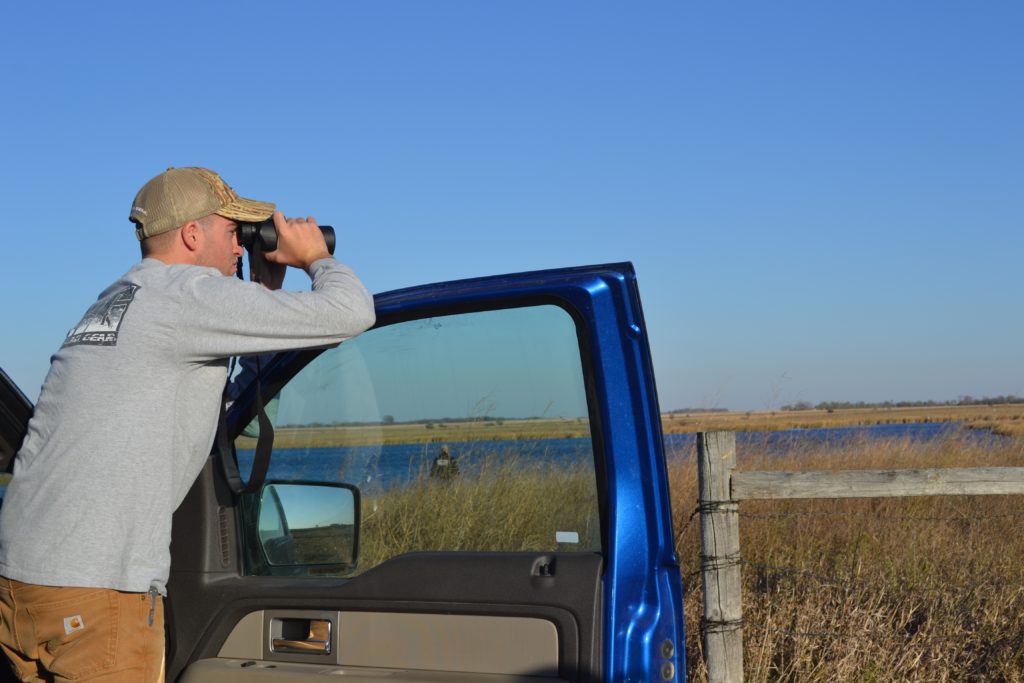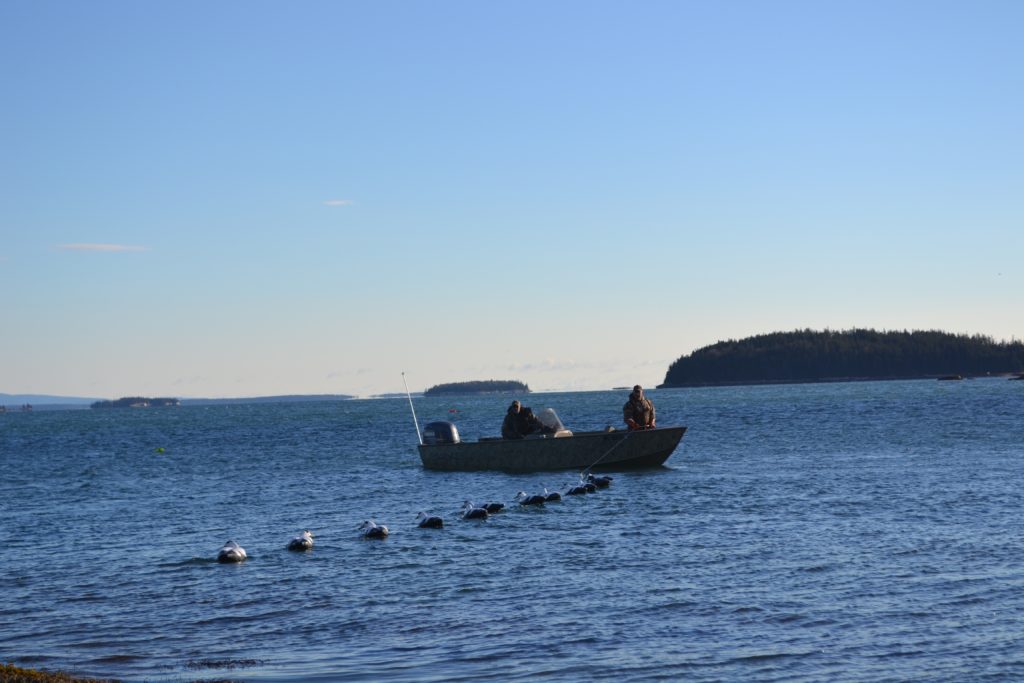Are you a puddle duck hunter thinking of hunting diving ducks? Mallard purists are accustomed to puddlers circling, working the decoys and committing with wings cupped and feet down, hovering over the landing hole. If you do a lot of that kind of hunting, you get to thinking you’re a pretty good shot. Then one day you find yourself in an ice-covered johnboat with two other hunters and an 80-pound Lab that can’t sit still, in the middle of one of Minnesota’s 10,000 lakes, and you’re rocking back and forth and a pair of canvasbacks are right there a foot above the water for a second and then they’re gone, and you’re thinking “this is awesome, but I’ll never kill anything.”
Hunting diving ducks, as I learned that day from Minnesota duck fanatic Mark Brendemuehl, is addictively masochistic. There are arguably more variables than in puddle duck hunting. It’s unpredictable and the potential for disaster on the water is higher. Some would argue that it’s downright crazy to “go to all that trouble for a few stinkin’ ducks,” but then duck hunters never have been considered the most sane individuals.
If you’re up for the diver-hunting challenge, here are a few tips to get you started.
Scouting
Diver hunters make their own success behind the windshield. We put hundreds of miles on the truck in just three days of diver hunting in Minnesota that week. Obviously, the first thing you want to see is the birds, and the more the better. Once you locate the birds in good numbers and figure out where they’re resting and where they’re feeding, you can start nailing down a spot to hunt in between those two locations — but finding a spot that will work isn’t a piece of cake. You need a spot that offers cover to hide in. If you’ll be hunting out of a boat, you’ll need to figure out how to access the spot and where to hide the boat. If you’ll be wading in, you have to worry about water depth and finding solid bottom. “This isn’t as easy for diver hunters because of water depths,” says Brendemuehl. “Puddle duck hunters have it easier, for sure!”

Finding birds is just the start — you also have to plan a way into and out of the X, consider the depth of the water and how it'll work with your boat, and get permission to hunt the spot.
If you’re on unfamiliar waters and don’t have a handheld GPS, you can use one of the many available smartphone apps to show you real-time position and upcoming structure. That will help you navigate and find the best setup.
On top of all that, you still have to make sure you have permission to hunt this X you’ve finally found.
Setup
“Any time I can set up with the sun at my back, I am going to do that,” says Brendemuehl. If all goes according to plan and you have a large flock of divers coming in, there will be a lot of eyes on you. If you can use the sun to your advantage to make it harder for all those eyes to pick you out, do it.
What about the wind? Though you do want the wind at your back if you can get it, you can compromise that a little to get the sun right. Brendemuehl will hunt a crosswind that puts the sun at his back every time.
If you have the luxury, try to set up your landing pockets at optimal range to strike the perfect balance of pattern size and density. That range will vary based on the patterning you’ve done with your shotgun, of course, and keep in mind that fast-flying divers can cover a lot of distance after the first trigger pull.
Decoys
Don’t get carried away with decoys when you're hunting diving ducks. Use common sense and the intel you gathered on your scouting trips to tell you how many lines to put out and how long they should be.
“Though divers generally like to see large groups of decoys,” Brendemeuhl says, “I think you still need to be realistic. If you’re seeing only smaller groups of divers, and there isn’t a lot of pressure from other hunters, smaller numbers of good-quality decoys can be more effective than large groups of blocks.” Be sure to diversify the species you use in this situation.
What species you choose will depend on the situation and what kind of birds are in the area, but in general, keep in mind that black and white both stand out on the surface of the water. For this reason, it’s a good idea to mix your species and throw in some coots.
“Coots are not commonly used in the North,” Brendemuehl says, “but they should be, because they work! If redheads are in the area, in particular, consider using a lot of coot decoys. The two are often seen together on the water in close proximity. Redheads will decoy extremely well to coot decoys!
“Also, maybe I am giving them more credit than they deserve,” he continues, “but I like to have my decoy rigs different than other hunters’ so they look more natural.”

Long, straight lines of diver decoys are what you want. If all goes according to plan, low-flying divers will hit the line and follow it right to you.
Decoy setup can be time-consuming, but gang-rigging your decoys will help cut down on setup time and will help keep your main line of decoys straight. It’s common for divers to “follow the line” of decoys straight to you, so putting dekes out in lines and keeping them relatively straight is important.
Keep your main line (or “motherline”) low enough in the water so dogs can swim through the decoys without getting tangled up, and low enough that boats can drive over the main line without hooking it with oars or paddles or cutting the line with a motor. Hunting diving ducks has enough potential for headache — the last thing you want is a tangled dog or boat on top of everything else.
Guns & Loads
The first rule of hunting diving ducks is to make sure they're dead. Divers are notoriously tough, and they can dive immediately upon hitting the water, even when crippled. “They sit so low in the water, and are so aerodynamic, and often have so much fat on them, it can take multiple shots to finish a diver,” says Brendemuehl. “Goldeneyes are notorious for taking a beating and still getting away!”
If possible, Brendemuehl designates one hunter as a “cleanup” shooter for any cripples. Getting a finishing shot on a wounded bird as quickly as possible will greatly improve your chances of recovering the bird. If nothing else, he encourages all hunters to save one shot for possible cripples. You wouldn’t believe how much distance a crippled diver can put between you and him while you’re reloading your shotgun.
Size 2 or 3 shot is common for decoying divers, and Brendemuehl agrees, but he often loads a shell of BB as his third shot just in case he has to reach out and touch a cripple on the water.
It’s critical to know your gun and your choke/load combination and be familiar with how it patterns before you go hunting diving ducks. This will help you call the shot at the moment of truth, when birds are in the perfect range for your optimum pattern density and power. “If you can time the shot for when the birds are decelerating, feet down instead of flying like a dang jet, the odds are just better,” Brendemuehl says. “I know, it’s a lot to think about, but why not put the odds in your favor?"






